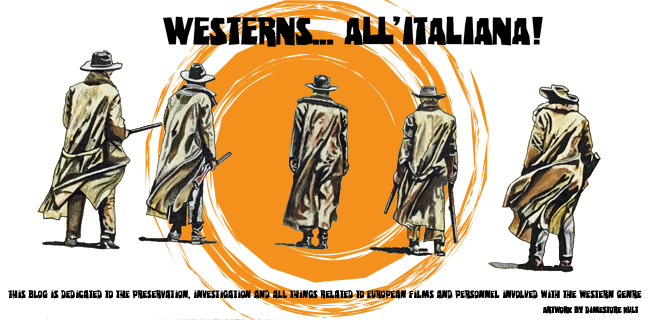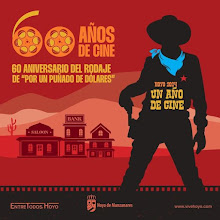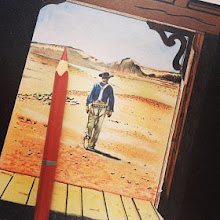The Scotland Herald
By James Mottram
EARLIER this year, cable giant HBO made an announcement
that made fans rejoice: after a decade in the wilderness, Deadwood was finally
coming to the big screen. The profane, violent Western, starring Ian McShane,
was cancelled in 2006 after its third season. But, finally, HBO programming
president Michael Lombardo has given the go-ahead for creator David Milch to
pen the longed-for film, bringing to a conclusion storylines that have been
left dangling for a decade.
For fans, it’s yet another tantalizing nugget in
Hollywood’s ongoing – and somewhat troubled – relationship with the genre. This
year has already seen Quentin Tarantino’s wintry Wyoming-set The Hateful Eight
draw solid reviews, impressive box-office and three Oscar nominations.
Alongside it the equally chilling epic The Revenant, an 1823-set frontier story
starring Leonardo DiCaprio as real-life fur-trapper Hugh Glass, which will
compete for 12 Oscars at the end of the month.
This month another horse opera clip-clops into cinemas:
S. Craig Zahler’s Bone Tomahawk, a slow-burning but ultimately savage story
about four men (including The Hateful Eight’s Kurt Russell) who go on a rescue
mission after two people are kidnapped from the town of Bright Hope. Marking
his directorial debut, Zahler is well-versed in Western mythology. His first
two novels – A Congregation of Jackals (2010) and Wraiths of the Broken Land
(2013) – are both set in the Old West.
More than most Zahler knows just how difficult it is to
get a Western green-lit by the studios these days. He penned two scripts that
didn’t get made. “I had a number of A-List directors and celebrities move off a
Western script that I wrote,” he sighs. “One of the reasons is that they
haven’t done that well, and one of the reasons for that is that the ones that
are getting made in Hollywood are s**t for the most part! And they [the
studios] feel that there needs to be some really in-your-face gimmick.”
Indeed for a genre that was so popular in the 1940s and
1950s, both on film and on television, it’s staggering to think just how far
it’s slid. While the genre was winding down by the 1970s, there were still
Westerns out there – from Clint Eastwood’s The Outlaw Josey Wales to The
Shootist with John Wayne (both 1976). Arguably, it was the financial disaster that
was Michael Cimino’s Heaven’s Gate, the 1980 film that brought the studio
United Artists to the brink of ruin, that ultimately saw the Western hung out
to dry.
Since then, the genre has been revived fitfully –
occasionally brilliantly in the case of Eastwood’s Pale Rider and Oscar-winning
Unforgiven. Like Eastwood, actors such as Kevin Costner (with Dances With
Wolves and Wyatt Earp) and Kurt Russell (in Tombstone) epitomised the Wild
West, even if their efforts failed to open the floodgates at the studios.
Instead, the comic book movie became the go-to source for blockbuster
entertainment and the Western was left in the last-chance saloon.
Indeed, it’s no surprise the genre has struggled, with
Hollywood convinced that modern audiences need more than merely cowboys and
Indians. Zahler’s notion that there needs to be an “in-your-face gimmick” is by
no means wide of the mark. Recent disappointments include Cowboys & Aliens
(Daniel Craig, fighting extra-terrestrials); The Lone Ranger (Johnny Depp as the
Native American sidekick Tonto, with a crow on his head) and Jonah Hex (Josh
Brolin, with supernatural abilities).
While Cowboys & Aliens and The Lone Ranger globally
made $174 million and $260 million respectively, both were perceived as flops,
given their exorbitantly high budgets. If this was another nail, then, in the
Western’s coffin, it seems some directors are refusing to believe the genre is
dead. Last year, Scottish-born director John Maclean delivered the sublime Slow
West, starring Michael Fassbender, a film steeped in classics of the genre like
Shane, My Darling Clementine and Rio Bravo.
It was the polar opposite of the gimmick-laden Westerns,
with its gradual pacing and its careful character development. About a young
Scot (Kodi Smit-McPhee) who travels to the American West in search of his lost
love when he encounters Fassbender’s bounty hunter, “I wanted to maybe go back
to the melodrama of early westerns, the love story and journey westerns,”
Maclean stated during the film’s promotional push.
While Slow West dealt with the migration to the Old West,
with the arrival of Scottish, Irish, German, Scandinavian and even African
characters, it was a theme also explored in Kristian Levring’s The Salvation,
also released last year, in which Mads Mikkelsen played a Danish settler, who
arrives in America to prepare for the arrival of his wife and child. “For that
reason I think that we can take the Western genre and say it belongs to
Europe,” says Mikkelsen, “and not necessarily to America.”
Levring’s film was full-on homage, with deliberate nods
to the works by the titans of the genre, directors like John Ford, Sergio Leone
and Clint Eastwood. Levring himself claimed it contained 62 different references
to the genre. Setting itself far apart from Slow West, which boasted an
outsider perspective, it was an unashamed love letter to the Western – proof,
perhaps, that filmmakers haven’t forgotten how the West was won.
Arguably, Tarantino is the director most responsible for
reviving the genre. In 2012, he delivered his Oscar-winning slavery drama
Django Unchained, starring Jamie Foxx – nodding to the 1966 Spaghetti Western
by Sergio Corbucci’s Django, not to mention slave films like Mandingo and the
blaxploitation Western The Boss (both made in 1975). Post The Hateful Eight, he
recently hinted he has more planned. “You have to make at least three Westerns
to call yourself a Western director. Anything else, you’re just dabbling.”
In the case of Bone Tomahawk, Zahler added a twist of his
own (though you’d be hard pressed to call it a ‘gimmick’). The foes met by
Russell’s Sheriff Hunt and his posse (Patrick Wilson, Matthew Fox and Richard
Jenkins) are a fictional tribe of cannibalistic savages called the Trogladytes.
“I wanted to create a race that was unlike anything you had seen before,” says
Zahler, who didn’t want to depict the Native Americans as the enemy.
Inspired by the Lost Race fiction of H. Rider Haggard
(King Solomon’s Mines), Edgar Rice Burroughs (At The Earth’s Core) and Abraham
Merritt (Dwellers In The Mirage), Zahler’s film is proof at how malleable the
genre is. The final act explodes into violence; some have gone so far as to dub
it a ‘Horror-Western’. “To me, this is a Western that has very strong horror
scenes but is also part of the Lost Race fiction discipline,” argues Zahler.
“Kurt has said it’s a graphic Western. That’s what it is.”
In Zahler’s eyes, it fulfils the requirements of the
Western first and foremost.
“And I’m a huge horror fan – this isn’t one of these
things where they make a horror movie and they start calling it a thriller,” he
adds. “I adore horror movies! But if I made a horror movie, the bottom line
would be, ‘I want to scare you all the time.’ It wouldn’t be an adventure
story, where the frontier of the West is the moral and physical crucible for
the protagonist, and that’s how I define a Western and that’s what this movie
is.”
Neither is Bone Tomahawk the last of this revival. Still
to come is Jane Got A Gun, the long-delayed Western that, like Slow West, has a
strong Scottish connection. Originally, Glasgow-born director Lynne Ramsay
earmarked the project as her follow-up to 2011’s acclaimed adaptation of We
Need To Talk About Kevin. With Natalie Portman on board as the star and
producer, Ramsay quit on the very first day production was due to begin in
Santa Fe, New Mexico.
With Ramsay replaced by Gavin O’Connor, the film was
eventually completed, with Ewan McGregor cast as the film’s main antagonist – a
vengeful gang-leader who crosses paths with Portman’s farmer’s wife. Recently
released quietly in the US – a sure sign that backers The Weinstein Company
were looking to wash its hands of the experience – the film actually received
reasonable reviews, with trade paper Variety calling it “a solidly made and
conventionally satisfying Western.”
Others are also readying for release – including a remake
of The Magnificent Seven with Denzel Washington, Forsaken with Kiefer and
Donald Sutherland, Brimstone with Kit Harrington and Diablo with Scott (son of
Clint) Eastwood. Is the Western back? It will depend, of course, on whether
audiences flock to see them – but Zahler estimates we could do with a change of
pace. “Patient viewers who want to sink into the West and into those rhythms…I
think it will be rewarding.” Time to saddle up.
[My personal
take on this is yes the Western is back… for a short time. More westerns have
been made and released in the last year than probably the last decade. The
problem with it being a successful return is even if they are made they are
being shown in most cinemas or theaters. Example “Slow West” when released
played in one theater in all of Los Angeles County. It was shown twice a day at
one Orange County Art Theater. It was pulled after two weeks. “Diablo” and
“Bone Tomahawk” was shown in only one theater in Los Angeles and none in Orange
County. “Forsaken” is playing at one theater in L.A. and none in Orange County.
“Jane Got a Gun” got a bigger theater release but was pulled after one week.
Only “The Hateful 8” and “The Revenant have seen general release. So the western
may be back but it is being sabotaged by not being generally released which
means we have to download, rent or buy them on DVD. Their sales will not
compare to a theater release and producers will once again claim they don’t
make money. See any of them while you can because like they have for 35 years
fade away quickly. Tom Betts]


















Biltmore: Add in "Winnetou and Shatterhand"
ReplyDelete